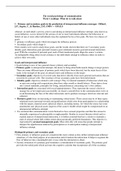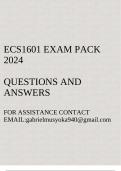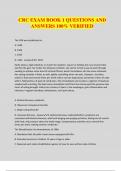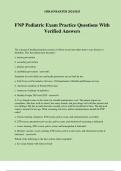The social psychology of communication
Week 1 readings: What do we talk about
1 - Primary and secondary goals in the production of interpersonal influence messages - Dillard,
J.P., Segrin, C., & Harden, J.M. (1989) — GOALS
Abstract: an individual’s activity, prior to and during an interpersonal influence attempt, (also known as
social influence, occurs whenever the actions of one or more individuals influence the behaviour or
beliefs of one or more other individuals) may the explained by his or her goals. We have two classes of
goals:
• primary or influence goals which investigate the influence process
• Secondary goals which shape it
Three studies were used to study those goals, and the results showed that there are 5 secondary goals:
identity goal, interaction goal, personal resource goal, relational resource goal and arousal interaction
goal. With the exception of personal goal, each of then mentioned goals shape the source’s actions
An indisputable thing about social existence is hat individuals attempt to influence others in order to
achieve their own ends.
Goals and interpersonal influence
• Goals belong to now of two general classes: primary and secondary
• Primary goals: in interpersonal attempts, the desire to bring about behavioural change in target person.
There are many different types of primary goals which have been detected, but the main focus of this
study is the strength of the goal, its attractiveness and influence on the target
• Secondary goals: objectives of several sorts that derive directly from more general motivations that are
recurrent in a person’s life. The existence of four secondary goals have been determined
• Identity goals: objectives related to self-concept. They’re internal standards of behaviour which may
or may not overlap with expectations about how other would or should behave. There derive from
one’s moral standards, principles for living, and preferences concerning one’s own conduct.
• Interaction goals are concerned with social appropriateness. They represent the source's desire to
manage his or her impression successfully, to ensure a smooth flow to the communication event, to
avoid threatening the face of the other interactant, and to produce messages which are relevant and
coherent
• Resource goals focus on increasing or maintaining valued assets. Those assets may be of three types:
relational assets (personal rewards and gratifications which arise from participation in a relationship
with the target), material assets (physical objects, including money, for which the source has some
attachment) and physical assets (aspects of the source's health which might be compromised in an
interpersonal influence attempt)
• It is assumed that communication events themselves have arousal properties and that this arousal is
internally experienced as pleasurable or unpleasurable. Similar to several theories which seek to
explain aspects of interpersonal interaction, it is further assumed that have a desire to maintain a
state of arousal which falls within certain idiosyncratically preferred boundaries. This objective is
represented by arousal management goals. Most often this will mean that people attempt to
dampen the apprehension induced by participation or in anticipation making a interpersonal
influence attempt.
Distinguish primary and secondary goals
• First, primary or influence goals are considered the more central as they define interpersonal influence
situations, it’s the chief purpose of an interaction and it brackets the interaction. It helps to segment the
flow of behavior into a meaningful unit; it says what the interaction is about.
• Second, awareness of a primary goal stimulates a consideration of secondary goals. The primary goal
provides the initial push which activates the cognitive calculus that incorporates all of the secondary
, goals. Secondary goals then function to shape, and typically to constrain, the behaviors whose
overriding purpose is to alter the behavior of the target.
• It is important to note that the notion of influence goal alone has no substance. Rather, that content must
be drawn from the substance of one or more of the secondary goals.
2 - Greene, J. O. (1984). A cognitive approach to human communication: An action assembly
theory. Communication Monographs, 51, 289–306 — ASSEMBLY THEORY
• Communicative behaviour is at once novel and creative yet patterned and repetitive. The social
behaviour of any individual is composed of a repertoire of repetitive word, topic, themes and
instrumental phrases, yet any particular discourse is almost certainly a unique combination of these
elements.
• Systems of communication output involve two basic processes: selection of old elements and
construction of novel patterns. These processes of selection and construction clearly involve issues of
memory storage, retrieval and utilisation. Those two process have been identified as crucial for research
in language and cognition
• Cognitivism: the task of the theorist is to provide an account for observed input-output regularities by
articulating the nature of the structures and processes responsible for those regularities
• Cognitivism: The use of thoughts to form hypothesis / Cognitivism is a learning theory that focuses on
the processes involved in learning rather than on the observed behavior / the psychology of learning
which emphasises human cognition or intelligence as a special endowment enabling man to form
hypotheses and develop intellectually / Cognitive psychology is the scientific study of the mind as an
information processor.
• In cognitive approaches, the idea of one to one correspondence between processes and brain structure is
not fully supported
A general theoretical framework:
• The human mind comprises of both conceptual and procedural knowledge. Conceptual = “knowledge
that”, procedural = “knowledge how”
• Procedural knowledge refers to those things we have learned to do, or not to do, to act in life
• Procedural memory comprises of action-outcome contingencies; and we rely on past action-outcome
contingencies to guide behavior.
• Procedural memory is modular. It is organised on the basis of a large number of elemental units, each
of which relates to an aspect of the outcome problem. The action component of each element specifies
the subset of parameters that define behavior.
• The production of novel behavior requires decomposition of complex elements into more fundamentals
units, as part of a storage system.
• Cognitive theorists proposed scripts and events schemata because many elements of behavior repeat
themselves in different contexts.
• Storing procedural information as distinct units allows for new information to be easily accommodated.
• A memory system composed of many modular elements would not require major restructuring as new
knowledge is acquired
• A modular conception of the elements of procedural memory provide a solution to the problem of
production of novel behaviour, storage requirements, and knowledge acquisition.
• There is some kind of selection process which acts when behaving, because not all elements of the
procedural store impact all behaviours
• For a particular record to impact upon behavior, its level of activation must exceed a certain threshold.
The occurrence of a goal or desired outcome which matches previous outcomes should result in
activation of records which contain those outcomes.
• Activation levels are also a selection process as the selected elements should be most effective in this
situation
,• Activation conditions of elements are compromised by desired outcomes and initial conditions which
have proven relevant in past goals pursuits. While a given goals may excite a number of action-outcome
records, the most higgle activated elements will be those with initial conditions which match present
conditions. In this way, only the most appropriate procedure will play a role in output production.
• Aside form their activation condition, procedural records have another property being the relationship
between the cation and the outcome. On a single trial basis, this relationship is rather weak. However
when it’s an often repeated activated procedure which constantly results in the desired outcome, it
increases the strength if the relationship.
• Many activation of procedural records and conceptual memories might be activated simultaneously at a
given moment and it is the communicator’s task to integrate them and select the relevant one for the
given action and moment. This integration is modified depending on the goals, actions and situation.
• The output reflect and integrated many levels, from general plan to muscle commands. It’s composed of
many different abstraction levels, from high-level conceptual representation to low-level motor codes.
3- Goldsmith, D.J., & Baxter, L.A. (1996). Constituting relationships in talk: A taxonomy of speech
events in social and personal relationships. Human Communication Research, 23, 87-114 —
SPEECH EVENTS
• Abstract: In the conducted study, everyday discussions were dominated by six kinds of talk events:
gossip, making plans, joking around, catching up, small talk and recapping of days events. The
taxonomy of speech events appears to be organised along three dimensions: formal/goal-directed,
important/deep/involving, and positive valence. Evidence have suggested how different types of
personal relationships are constituted in different speech events.
The importance of “speech event” construct
• Speech events are important building blocks of communication.
• Communication styles and events between different partners form relations between them, different
relationships use different speech events
• Small talk has been seen as a way of accomplishing the relationship goal and increasing the intimacy of
the relationship
• Speech events are important to understand the function of the communication as well as the nature of
the relationship. The speech events can also help evaluate the changes over time in the relationship
• This article studied how vocabulary of speech events types can be used to indicate functions of
communication in relationships.
• The research has been related to four bodies of research
• Diary studies (research method used to collect qualitative data about user behaviors, activities, and
experiences over time): it has been shown that the value and quality of communication differs for
acquaintances, friends, lovers and family
• Studies of situations: also studies the different relationships between individuals in the study based on
their kind of communication and speech events
• Research on cognitive memory structures: speech events are not simply shared in cognitive structures,
its rather a social not psychological concept. When studying speech events the focus is not put on
using them to explain social behaviors but rather to describe etc types of episodes and ultimately
relationships. With those speech events the focus is not put on the cognition.
• Ethnographic studies of speech events: the study of speech events wasn’t to illuminate cultural systems
of beliefs but rather then study of the frequency of those events in different types of social and
personal relationships
Events that constitute relationships
, • The taxonomy of speech events provides a basis for identifying the types of events and frequency of
events that occur in social and personal relationship and for locating common patterns in the ways in
which talk constitutes these relationships
• I has been seen that in dyadic interactions (2 people), 48.9% of the communication fall under five
speech events: gossip, joking around, catching up, small talk and recapping the day’s events
• The informal superficiality of acquaintanceship was dominated by small talk, with secondary presence
of joking around, getting to know someone talk and gossip.
• The informal superficiality of close friendship is dominated by gossip, secondary emphasis on catching
up, joking around and recapping the day’s events.
• Superficial informal talk between romantic partners emphasises recapping of the day’s events and
morning talk with secondary emphasis on joking around, gossip, and bedtime chat.
• Informal superficiality in parent-child interaction is enacted most frequently in the form of catching up,
recapping the day’s events and gossip.
• For siblings, its largely gossip, catching up and joking around.
• In short, different relationships forms appear to enact qualitative different typed of informal, superficial
speech events.
• Purposive events with particular goals are more formalised and contain a good amount of plan-making.
Purposive talk were not only found in acquaintances but also in closer relationships. Deep conversation
and love talks only accounted for small portions of the cases in the conducted study.
• Many speech events that share a similar dimensional profile cannot function as equivalent for one
another. Ex: Gossip is rather okay between close friends but can be seen as threatening with
acquaintance.
• Gossip has been reported to be the most common speech event used, is a way of social networking and
sharing of resources of information and knowledge
Conclusion of the study
• Taxonomy of speech events can be used to address traditional concerns of researches in the areas of
interpersonal communication and personal relationship
• The results are also relevant to conceptualise the fact that relationships are a work in progress and not in
a static state. Many relationship features such as trust, mutual knowledge might be built during
conversations and communication
• Relationship parties have a large, shared repository of speech event types with which to constitute a
diverge range of relationship forms
4- Baumeister, R.F., Zhang, L., & Vohs, K.D. (2004). Gossip as cultural learning. Review of General
Psychology, 8, — GOSSIP
• Gossip has often been regarded as a malicious desire to harm others by staging their reputation, but it
has been seen that aside from that, gossip also serves as a source of information and knowledge to
people, relating to the person in question or to certain social norms or even to certain situations
• There are two different functions that can be subsumed under the view that gossip serves social
relationships.
• The bond between teller and hearer may be strengthened as they spend time in conversation together
and perhaps share information of mutual interest.
• The information contained in the gossip may be useful to the hearer for learning about the target
person, assuming that the target person is someone within the hearer’s social sphere so that the
hearer can pursue that relationship more effectively by virtue of having gained more information
about him or her.
• Humans live in a certain culture, they respect and follow social and cultural norms. Gossip has been
proved to be a good way to inform and transmit information about those norms and rules which guide
Week 1 readings: What do we talk about
1 - Primary and secondary goals in the production of interpersonal influence messages - Dillard,
J.P., Segrin, C., & Harden, J.M. (1989) — GOALS
Abstract: an individual’s activity, prior to and during an interpersonal influence attempt, (also known as
social influence, occurs whenever the actions of one or more individuals influence the behaviour or
beliefs of one or more other individuals) may the explained by his or her goals. We have two classes of
goals:
• primary or influence goals which investigate the influence process
• Secondary goals which shape it
Three studies were used to study those goals, and the results showed that there are 5 secondary goals:
identity goal, interaction goal, personal resource goal, relational resource goal and arousal interaction
goal. With the exception of personal goal, each of then mentioned goals shape the source’s actions
An indisputable thing about social existence is hat individuals attempt to influence others in order to
achieve their own ends.
Goals and interpersonal influence
• Goals belong to now of two general classes: primary and secondary
• Primary goals: in interpersonal attempts, the desire to bring about behavioural change in target person.
There are many different types of primary goals which have been detected, but the main focus of this
study is the strength of the goal, its attractiveness and influence on the target
• Secondary goals: objectives of several sorts that derive directly from more general motivations that are
recurrent in a person’s life. The existence of four secondary goals have been determined
• Identity goals: objectives related to self-concept. They’re internal standards of behaviour which may
or may not overlap with expectations about how other would or should behave. There derive from
one’s moral standards, principles for living, and preferences concerning one’s own conduct.
• Interaction goals are concerned with social appropriateness. They represent the source's desire to
manage his or her impression successfully, to ensure a smooth flow to the communication event, to
avoid threatening the face of the other interactant, and to produce messages which are relevant and
coherent
• Resource goals focus on increasing or maintaining valued assets. Those assets may be of three types:
relational assets (personal rewards and gratifications which arise from participation in a relationship
with the target), material assets (physical objects, including money, for which the source has some
attachment) and physical assets (aspects of the source's health which might be compromised in an
interpersonal influence attempt)
• It is assumed that communication events themselves have arousal properties and that this arousal is
internally experienced as pleasurable or unpleasurable. Similar to several theories which seek to
explain aspects of interpersonal interaction, it is further assumed that have a desire to maintain a
state of arousal which falls within certain idiosyncratically preferred boundaries. This objective is
represented by arousal management goals. Most often this will mean that people attempt to
dampen the apprehension induced by participation or in anticipation making a interpersonal
influence attempt.
Distinguish primary and secondary goals
• First, primary or influence goals are considered the more central as they define interpersonal influence
situations, it’s the chief purpose of an interaction and it brackets the interaction. It helps to segment the
flow of behavior into a meaningful unit; it says what the interaction is about.
• Second, awareness of a primary goal stimulates a consideration of secondary goals. The primary goal
provides the initial push which activates the cognitive calculus that incorporates all of the secondary
, goals. Secondary goals then function to shape, and typically to constrain, the behaviors whose
overriding purpose is to alter the behavior of the target.
• It is important to note that the notion of influence goal alone has no substance. Rather, that content must
be drawn from the substance of one or more of the secondary goals.
2 - Greene, J. O. (1984). A cognitive approach to human communication: An action assembly
theory. Communication Monographs, 51, 289–306 — ASSEMBLY THEORY
• Communicative behaviour is at once novel and creative yet patterned and repetitive. The social
behaviour of any individual is composed of a repertoire of repetitive word, topic, themes and
instrumental phrases, yet any particular discourse is almost certainly a unique combination of these
elements.
• Systems of communication output involve two basic processes: selection of old elements and
construction of novel patterns. These processes of selection and construction clearly involve issues of
memory storage, retrieval and utilisation. Those two process have been identified as crucial for research
in language and cognition
• Cognitivism: the task of the theorist is to provide an account for observed input-output regularities by
articulating the nature of the structures and processes responsible for those regularities
• Cognitivism: The use of thoughts to form hypothesis / Cognitivism is a learning theory that focuses on
the processes involved in learning rather than on the observed behavior / the psychology of learning
which emphasises human cognition or intelligence as a special endowment enabling man to form
hypotheses and develop intellectually / Cognitive psychology is the scientific study of the mind as an
information processor.
• In cognitive approaches, the idea of one to one correspondence between processes and brain structure is
not fully supported
A general theoretical framework:
• The human mind comprises of both conceptual and procedural knowledge. Conceptual = “knowledge
that”, procedural = “knowledge how”
• Procedural knowledge refers to those things we have learned to do, or not to do, to act in life
• Procedural memory comprises of action-outcome contingencies; and we rely on past action-outcome
contingencies to guide behavior.
• Procedural memory is modular. It is organised on the basis of a large number of elemental units, each
of which relates to an aspect of the outcome problem. The action component of each element specifies
the subset of parameters that define behavior.
• The production of novel behavior requires decomposition of complex elements into more fundamentals
units, as part of a storage system.
• Cognitive theorists proposed scripts and events schemata because many elements of behavior repeat
themselves in different contexts.
• Storing procedural information as distinct units allows for new information to be easily accommodated.
• A memory system composed of many modular elements would not require major restructuring as new
knowledge is acquired
• A modular conception of the elements of procedural memory provide a solution to the problem of
production of novel behaviour, storage requirements, and knowledge acquisition.
• There is some kind of selection process which acts when behaving, because not all elements of the
procedural store impact all behaviours
• For a particular record to impact upon behavior, its level of activation must exceed a certain threshold.
The occurrence of a goal or desired outcome which matches previous outcomes should result in
activation of records which contain those outcomes.
• Activation levels are also a selection process as the selected elements should be most effective in this
situation
,• Activation conditions of elements are compromised by desired outcomes and initial conditions which
have proven relevant in past goals pursuits. While a given goals may excite a number of action-outcome
records, the most higgle activated elements will be those with initial conditions which match present
conditions. In this way, only the most appropriate procedure will play a role in output production.
• Aside form their activation condition, procedural records have another property being the relationship
between the cation and the outcome. On a single trial basis, this relationship is rather weak. However
when it’s an often repeated activated procedure which constantly results in the desired outcome, it
increases the strength if the relationship.
• Many activation of procedural records and conceptual memories might be activated simultaneously at a
given moment and it is the communicator’s task to integrate them and select the relevant one for the
given action and moment. This integration is modified depending on the goals, actions and situation.
• The output reflect and integrated many levels, from general plan to muscle commands. It’s composed of
many different abstraction levels, from high-level conceptual representation to low-level motor codes.
3- Goldsmith, D.J., & Baxter, L.A. (1996). Constituting relationships in talk: A taxonomy of speech
events in social and personal relationships. Human Communication Research, 23, 87-114 —
SPEECH EVENTS
• Abstract: In the conducted study, everyday discussions were dominated by six kinds of talk events:
gossip, making plans, joking around, catching up, small talk and recapping of days events. The
taxonomy of speech events appears to be organised along three dimensions: formal/goal-directed,
important/deep/involving, and positive valence. Evidence have suggested how different types of
personal relationships are constituted in different speech events.
The importance of “speech event” construct
• Speech events are important building blocks of communication.
• Communication styles and events between different partners form relations between them, different
relationships use different speech events
• Small talk has been seen as a way of accomplishing the relationship goal and increasing the intimacy of
the relationship
• Speech events are important to understand the function of the communication as well as the nature of
the relationship. The speech events can also help evaluate the changes over time in the relationship
• This article studied how vocabulary of speech events types can be used to indicate functions of
communication in relationships.
• The research has been related to four bodies of research
• Diary studies (research method used to collect qualitative data about user behaviors, activities, and
experiences over time): it has been shown that the value and quality of communication differs for
acquaintances, friends, lovers and family
• Studies of situations: also studies the different relationships between individuals in the study based on
their kind of communication and speech events
• Research on cognitive memory structures: speech events are not simply shared in cognitive structures,
its rather a social not psychological concept. When studying speech events the focus is not put on
using them to explain social behaviors but rather to describe etc types of episodes and ultimately
relationships. With those speech events the focus is not put on the cognition.
• Ethnographic studies of speech events: the study of speech events wasn’t to illuminate cultural systems
of beliefs but rather then study of the frequency of those events in different types of social and
personal relationships
Events that constitute relationships
, • The taxonomy of speech events provides a basis for identifying the types of events and frequency of
events that occur in social and personal relationship and for locating common patterns in the ways in
which talk constitutes these relationships
• I has been seen that in dyadic interactions (2 people), 48.9% of the communication fall under five
speech events: gossip, joking around, catching up, small talk and recapping the day’s events
• The informal superficiality of acquaintanceship was dominated by small talk, with secondary presence
of joking around, getting to know someone talk and gossip.
• The informal superficiality of close friendship is dominated by gossip, secondary emphasis on catching
up, joking around and recapping the day’s events.
• Superficial informal talk between romantic partners emphasises recapping of the day’s events and
morning talk with secondary emphasis on joking around, gossip, and bedtime chat.
• Informal superficiality in parent-child interaction is enacted most frequently in the form of catching up,
recapping the day’s events and gossip.
• For siblings, its largely gossip, catching up and joking around.
• In short, different relationships forms appear to enact qualitative different typed of informal, superficial
speech events.
• Purposive events with particular goals are more formalised and contain a good amount of plan-making.
Purposive talk were not only found in acquaintances but also in closer relationships. Deep conversation
and love talks only accounted for small portions of the cases in the conducted study.
• Many speech events that share a similar dimensional profile cannot function as equivalent for one
another. Ex: Gossip is rather okay between close friends but can be seen as threatening with
acquaintance.
• Gossip has been reported to be the most common speech event used, is a way of social networking and
sharing of resources of information and knowledge
Conclusion of the study
• Taxonomy of speech events can be used to address traditional concerns of researches in the areas of
interpersonal communication and personal relationship
• The results are also relevant to conceptualise the fact that relationships are a work in progress and not in
a static state. Many relationship features such as trust, mutual knowledge might be built during
conversations and communication
• Relationship parties have a large, shared repository of speech event types with which to constitute a
diverge range of relationship forms
4- Baumeister, R.F., Zhang, L., & Vohs, K.D. (2004). Gossip as cultural learning. Review of General
Psychology, 8, — GOSSIP
• Gossip has often been regarded as a malicious desire to harm others by staging their reputation, but it
has been seen that aside from that, gossip also serves as a source of information and knowledge to
people, relating to the person in question or to certain social norms or even to certain situations
• There are two different functions that can be subsumed under the view that gossip serves social
relationships.
• The bond between teller and hearer may be strengthened as they spend time in conversation together
and perhaps share information of mutual interest.
• The information contained in the gossip may be useful to the hearer for learning about the target
person, assuming that the target person is someone within the hearer’s social sphere so that the
hearer can pursue that relationship more effectively by virtue of having gained more information
about him or her.
• Humans live in a certain culture, they respect and follow social and cultural norms. Gossip has been
proved to be a good way to inform and transmit information about those norms and rules which guide











